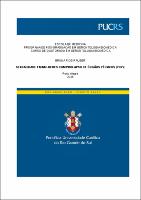| Share record |


|
Please use this identifier to cite or link to this item:
https://tede2.pucrs.br/tede2/handle/tede/11572| Document type: | Tese |
| Title: | Sexualidade em mulheres com prolapso de órgãos pélvicos (POP) |
| Author: | Rauber, Bruna Rios  |
| Advisor: | Schreiner, Lucas |
| Abstract (native): | O prolapso de órgãos pélvicos (POP) modifica a anatomia e a função das estruturas pélvicas, causando sintomatologias diversas e repercussões funcionais no compartimento vaginal. Os sintomas mais comumente descritos são relacionados às incontinências urinária e fecal e disfunções sexuais, podendo afetar o bem-estar biopsicossocial. Desta forma, o presente estudo avaliou o impacto do POP na sexualidade de mulheres sexualmente ativas. Estudo transversal, descritivo e analítico de caso-controle (CAAE: 7994123.0.0000.5336) que avaliou 34 mulheres acometidas por POP (grupo estudo) e 42 mulheres sem a disfunção (grupo controle), acompanhadas pelo Ambulatório de Uroginecologia do Hospital São Lucas da PUCRS. Foram analisados dados sociodemográficos (idade, estado civil, escolaridade, atividade laboral e religião) e aspectos clínicos (exame clínico, história ginecológica e sexual), ambos forma testados pelo teste Qui-quadrado. A sexualidade foi avaliada através do Índice de Função Sexual Feminina (FSFI) e do Questionário Sexual de Prolpaso de Órgãos Pélvicos/Incontinência Urinária (PISQ-12). As médias dos scores do FSFI e do PISQ-12 foram comparadas pelo teste T não pareado. Não houve associação significativa entre os dados demográficos e a presença ou ausência de POP. O POP predominante foi no compartimento anterior (61,76%), seguido do compartimento posterior (23,5%) e compartimento apical (14,7%). A prevalência de depressão autoreferida (23,52%) e o uso regular de álcool (14,70%) foi significativamente maior no grupo POP, quando comparado ao grupo controle (p=0,032 e 0,015, respectivamente). Mulheres com POP apresentaram piores escores nos domínios do FSFI, sem diferença significativa (p=0,288). O domínio “desejo” apresentou pior desempenho nas mulheres com POP em relação às sem POP, com tendência à significância estatística (p=0,076). O resultado do PISQ-12 entre os grupos com e sem POP revelou maior satisfação sexual nas mulheres sem POP, com diferença estatisticamente significativa (p=0,012). O presente estudo demonstrou que a função sexual de mulheres sexualmente ativas com POP é pior do que a de mulheres sem a disfunção, demonstrando o impacto do POP na função sexual, que é um fator importante na qualidade de vida. Inferimos que mulheres sexualmente ativas com prolapso genital podem melhorar sua função sexual após seu tratamento. |
| Abstract (english): | Pelvic organs prolapse (POP) modifies pelvis’s structures anatomy, causing different symptoms and functional repercussions in the vaginal compartment. The most reported symptoms are urinary and fecal incontinence and sexual dysfunctions, significantly affecting biopsychosocial well-being. Thus, the present study evaluated the impact of POP on the sexuality of sexually active women. This is a cross-sectional, descriptive and analytical case-control study (CAAE: 67994123.0.0000.5336) that evaluated 34 women affected by POP (study group) and 42 women without the dysfunction (control group), assisted by the Urogynecology Clinic of Hospital São Lucas at PUCRS. Sociodemographic data (age, marital status, education, work activity, and religion) and clinical aspects (clinical examination, gynecological and sexual history) were analyzed through the Chi square test. Sexuality was assessed using the Female Sexual Function Index (FSFI) and the Pelvic Organ Prolapse/Urinary Incontinence Sexual Questionnaire (PISQ-12). FSFI and PISQ-12 means scores were compared using the unpaired T test. There was no significant association between demographic data and the occurrence of POP. Most POP cases were found in the anterior compartment (61.76%), followed by the posterior (23.5%) and the apical compartment (14.7%). The prevalence of self-reported depression (23.52%) and regular alcohol use (14.70%) was significantly higher in the POP group when compared to the control group (p=0.032 and 0.015, respectively). Women with POP exhibited lower scores across the FSFI domains, although the difference was not statistically significant (p=0.288). The “desire” domain was notably lower in women with POP, approaching statistical significance (p=0.076). PISQ-12 results revealed greater sexual satisfaction in women without POP (p=0.012). Results of this study demonstrated that sexual function of sexually active women with POP is worsened, reinforcing its impact on sexual function and in quality of life. It is suggested that sexually active women with POP may improve their sexual function after treating the condition. |
| Keywords: | Prolapso de Órgãos Pélvicos Sexualidade Saúde da Mulher Pelvic Organ Prolapse Sexuality Women's Health |
| CNPQ Knowledge Areas: | CIENCIAS DA SAUDE::MEDICINA |
| Language: | por |
| Country: | Brasil |
| Publisher: | Pontifícia Universidade Católica do Rio Grande do Sul |
| Institution Acronym: | PUCRS |
| Department: | Instituto de Geriatria e Gerontologia |
| Program: | Programa de Pós-Graduação em Gerontologia Biomédica |
| Access type: | Acesso Aberto |
| Fulltext access restriction: | Trabalho não apresenta restrição para publicação |
| URI: | https://tede2.pucrs.br/tede2/handle/tede/11572 |
| Issue Date: | 13-Mar-2025 |
| Appears in Collections: | Programa de Pós-Graduação em Gerontologia Biomédica |
Files in This Item:
| File | Description | Size | Format | |
|---|---|---|---|---|
| RAUBER_BRUNA_RIO_TES.pdf | BRUNA_RIOS_RAUBER_TES | 5.64 MB | Adobe PDF |  Download/Open Preview |
Items in DSpace are protected by copyright, with all rights reserved, unless otherwise indicated.




